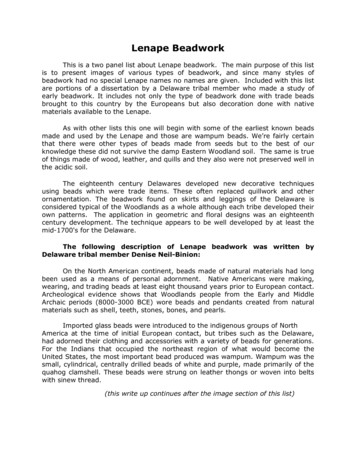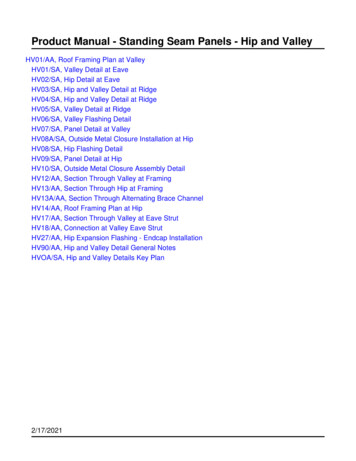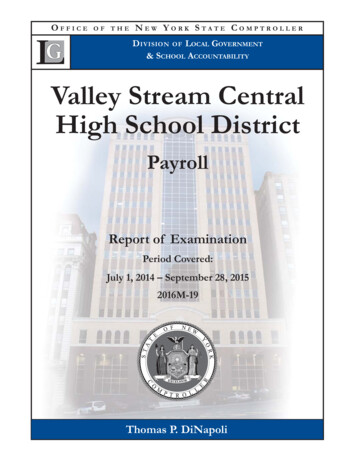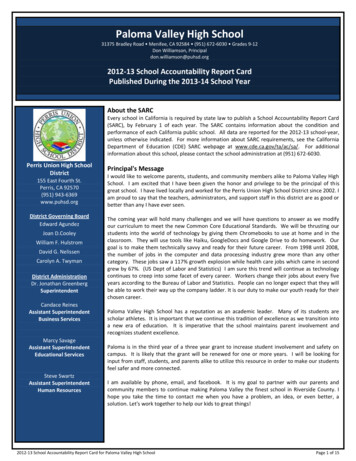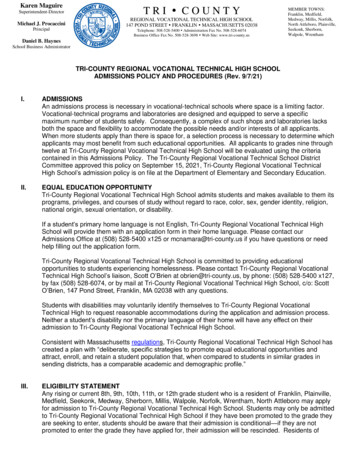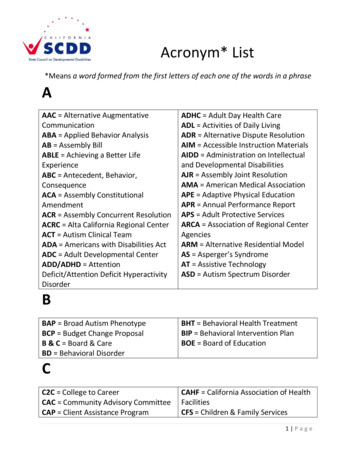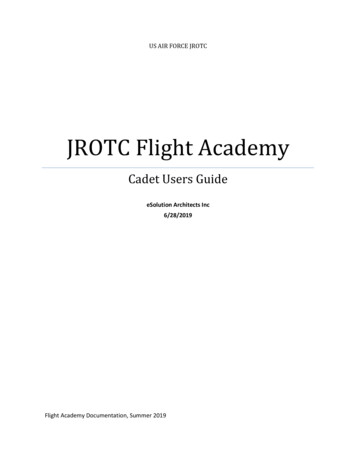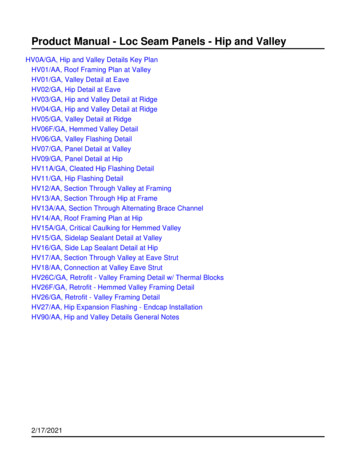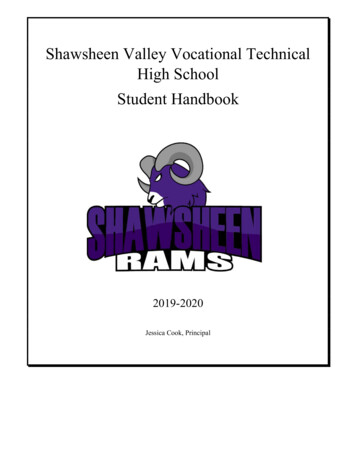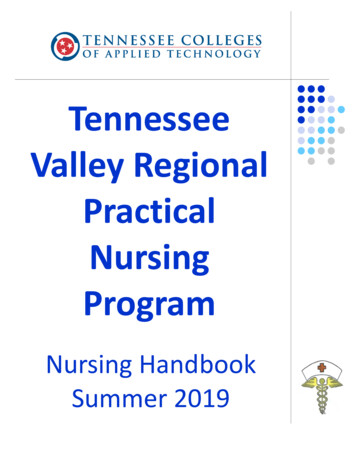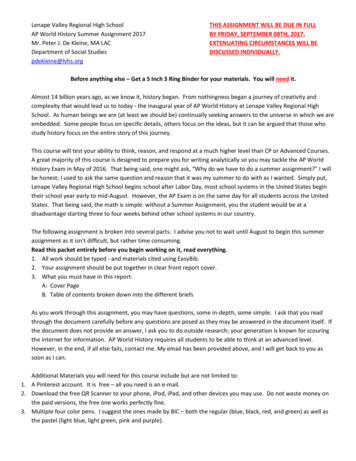
Transcription
Lenape Valley Regional High SchoolAP World History Summer Assignment 2017Mr. Peter J. De Kleine, MA LACDepartment of Social Studiespdekleine@lvhs.orgTHIS ASSIGNMENT WILL BE DUE IN FULLBY FRIDAY, SEPTEMBER 08TH, 2017.EXTENUATING CIRCUMSTANCES WILL BEDISCUSSED INDIVIDUALLY.Before anything else – Get a 5 Inch 3 Ring Binder for your materials. You will need it.Almost 14 billion years ago, as we know it, history began. From nothingness began a journey of creativity andcomplexity that would lead us to today - the inaugural year of AP World History at Lenape Valley Regional HighSchool. As human beings we are (at least we should be) continually seeking answers to the universe in which we areembedded. Some people focus on specific details, others focus on the ideas, but it can be argued that those whostudy history focus on the entire story of this journey.This course will test your ability to think, reason, and respond at a much higher level than CP or Advanced Courses.A great majority of this course is designed to prepare you for writing analytically so you may tackle the AP WorldHistory Exam in May of 2016. That being said, one might ask, “Why do we have to do a summer assignment?” I willbe honest; I used to ask the same question and reason that it was my summer to do with as I wanted. Simply put,Lenape Valley Regional High School begins school after Labor Day, most school systems in the United States begintheir school year early to mid-August. However, the AP Exam is on the same day for all students across the UnitedStates. That being said, the math is simple: without a Summer Assignment, you the student would be at adisadvantage starting three to four weeks behind other school systems in our country.The following assignment is broken into several parts. I advise you not to wait until August to begin this summerassignment as it isn’t difficult, but rather time consuming.Read this packet entirely before you begin working on it, read everything.1. All work should be typed - and materials cited using EasyBib.2. Your assignment should be put together in clear front report cover.3. What you must have in this report:A: Cover PageB. Table of contents broken down into the different briefsAs you work through this assignment, you may have questions, some in-depth, some simple. I ask that you readthrough the document carefully before any questions are posed as they may be answered in the document itself. Ifthe document does not provide an answer, I ask you to do outside research; your generation is known for scouringthe internet for information. AP World History requires all students to be able to think at an advanced level.However, in the end, if all else fails, contact me. My email has been provided above, and I will get back to you assoon as I can.Additional Materials you will need for this course include but are not limited to:1. A Pinterest account. It is free – all you need is an e-mail.2. Download the free QR Scanner to your phone, iPod, iPad, and other devices you may use. Do not waste money onthe paid versions, the free one works perfectly fine.3. Multiple four color pens. I suggest the ones made by BIC – both the regular (blue, black, red, and green) as well asthe pastel (light blue, light green, pink and purple).
4. Colored pencils. Crayola tends to be the best, but there are many brands out there.Brief I: Overview of the AP World History Course and Examination - (Quiz Grade worth 100 points)Read pages 1 through 23 of the AP World History Course and Exam as provided byCollege Board. (I have provided a direct link to the site below as well as a QR code incase you wish to access the material that way.) This reading will provide you with anoverview of the historical thinking skills that this course is intended to enhance as wellas the themes of world history that provide the framework for the course. I suggestprinting this out and putting it into your binder. As you read it, take notes on thematerials that you believe are pertinent to your success in this course.Nothing needs to be written for Questions 12 and 13 at this time. Familiarize yourselfwith this material, as you will be tested upon it when you come back to school. A testdate will be given upon your return to Lenape tion.pdf1. Define historiography.2. How might you become proficient in the historical thinking skill of Historical Argumentation?Cite an example of this skill.3. What should you be able to do to demonstrate Appropriate Use of Relevant Historical Evidence?4. Why does a course in World History not often rely on written sources as evidence? Whatsources do they use in lieu of written sources?5. How might you become proficient in the historical thinking skill of Chronological Reasoning? Citean example of this skill.6. What should you do to be able to demonstrate knowledge of Patterns of Continuity and ChangeOver Time?7. Why is Periodization challenging yet important in a study of World History?8. How might you become proficient in the historical thinking skill of Comparison andContextualization? Cite an example of this skill.9. What does it mean to Contextualize?10. How might you become proficient in the historical thinking skill of Historical Interpretation andSynthesis? Cite an example of this skill.11. Come up with one word to describe each of the five Course Themes.12. Memorize the following AP World Regions that are shown on page 33. They are Southeast Asia,East Asia, Central Asia, South Asia, The Middle East, North Africa, West Africa, Central Africa,Southern Africa (you cannot refer to it as South Africa as that is a modern nation-state), LatinAmerica & the Caribbean, and North America. You should also know Western Europe andEastern Europe.13. Memorize the six Unit Periods (shown on page 34) for the course.
Brief II: “After this course, I will never need this again in my life!” – Said the student(Quiz Grade worth 100 points)I have heard this statement time and time again, in numerous courses, from students from all walks oflife. “I will never need this again.” So why take a course on AP World History? I mean, what will thestudy of history actually do for you, the student? Will it prepare you for a better job / career in society?Will it land you the American Dream? Will the study of our collective past, present, and future help yourstanding in school or society?Utilizing the information in the materials provided below, in Brief II, write a thesis statement concerningwhy the study of history is important.Read the following (and again I suggest you print them out and put them into your binder):1. Why Study History (1985) by William H. McNeill2. Why Study History (1998) by Peter N. StearnsWhy Study History -history-(1985)Why Study History history-(1998)
ADDENDUM:Should you have difficulty writing a thesisstatement (which I don’t think you will) I haveincluded two additional links for you off ofPinterest, which will be helpful. QR Codes forthese links have been added as well. Payattention to the “3 point” 4/Brief III: TED Talks – The History of Our WorldWatch this brief Ted Talk given by David Christian (see link below). As you listen, take notes (I suggestjust listening to it through one time, then going back a few hours later and listening to it again but thesecond time – take notes). Afterward, write a one paragraph summary of the purpose of Christian’slecture. Be sure to support your answer with evidence from Christian’s point of view.http://www.ted.com/talks/david christian big history#t-1040321Print out the Interactive Transcript and include this in your binder.
Brief IV: “I’m the map, I’m the map, I’m the map .” you get it. (Test Grade worth 100 points)No study of history is complete without a proper understanding of where things are located in the worldand how those places have affected the course of human history. Create or print an outline map, whichyou can locate, and label each of theitems listed below. Items listed with acolor and number can be labeled usingthe appropriate color/numbercombination. All other items must beneatly hand drawn or outlined andclearly labeled.There are a few ways to create thismap activity. If you so choose, yourmap can be at least 11x17, but can beas large as 13x19 in size. However, ifyou are so inclined, you can create anoverlay map using Clear InkJetTransparency Film. If you do eachportion and overlay it accordingly youwill have a fully functional map torefer to throughout the year.You can use the following websites to test your knowledge of the rdsoftware.com/Geography.htm.Suggested reference for the physical geography maps: http://go.hrw.com/atlas/norm htm/world.htm.
Continents (RED)1. North America2. South America3. Australia4. Europe5. Antarctica6. Asia7. AfricaOceans, Seas, Bays, Lakes (BLUE)1. Atlantic Ocean2. Pacific Ocean3. Indian Ocean4. Arctic Ocean5. North Sea6. Baltic Sea7. English Channel8. Mediterranean Sea9. Adriatic Sea10. Aegean Sea11. Black Sea12. Caspian Sea13. Red Sea14. Persian Gulf15. Arabian Sea16. South China Sea17. East China Sea18. Sea of Japan19. Caribbean Sea20. Gulf of Mexico21. Great Lake Huron22. Great Lake Ontario23. Great Lake Superior24. Great Lake Michigan25. Great Lake Erie26. Great Slave Lake27. Great Bear Lake28. Lake Winnipeg
Rivers (GREEN)1. Nile River2. Tigris River3. Euphrates River4. Amazon River5. Indus River6. Yellow (Huang He) River7. Yangtze River8. Ganges River9. Mekong River10. Congo River11. Rhine River12. Danube River13. Niger River14. Volga River15. Ural River16. Dnieper River17. Elbe River18. Pearl River19. Groot River (Eastern, Western, and Southern Cape)20. Chari River21. Mississippi River22. Missouri River23. Ohio RiverDeserts (TAN or ORANGE)1. Gobi2. Kalahari3. Sahara4. Mojave5. Arabian6. Namib7. Great Victoria Desert8. Little Sandy Desert9. Great Sandy DesertMtn Ranges (BROWN )1. Himalayas2. Hindu Kush3. Andes4. Sierra Madre5. Alps
6. Appalachian7. Rocky Mountains8. Atlas9. Pyrenees Mountains10. Ural MountainsStraits (PURPLE)1. Bosporus Strait2. Strait of Magellan3. Strait of Gibraltar4. Strait of Malacca5. Dardanelles6. Strait of Hormuz7. Bering Strait8. Bass Strait9. Cook Strait10. Strait of Dover11. Detroit RiverAP World Regions- Color CodeNorth AfricaWest AfricaEast AfricaCentral AfricaSouthern AfricaMiddle East (Southwest Asia) East AsiaCentral AsiaSouth AsiaLatin America & the CaribbeanNorth AmericaWestern EuropeEastern EuropeOceaniaPeninsulas & Other Landforms (PINK)1. Arabian Peninsula2. Balkans3. Crimean Peninsula4. Horn of Africa5. Iberian Peninsula6. Yucatan Peninsula7. Great Rift Valley8. Asian Steppe
Brief V: Salt: A World HistorySomething new I would like to add to the course, which we will use throughout the year is a book calledSalt: A World History by Mark Kurlansky. All I am asking is that you read the first two chapters (just two)before the start of school.We will have an assignment using this text when we return to school - don’t worry, it won’t be insaneand it will help guide you to your ultimate goal - a 5 on the AP Test.The book can be found on Amazon for 1.99 (Kindle Edition) or 9.78 (Paperback).Either edition will do - as long as you have the ability to access it in class.
Almost 14 billion years ago, as we know it, history began. From nothingness began a journey of creativity and complexity that would lead us to today - the inaugural year of AP World History at Lenape Valley Regional High School. As human beings we are (at least we should be) continually seeking answers to the universe in which we are embedded.
